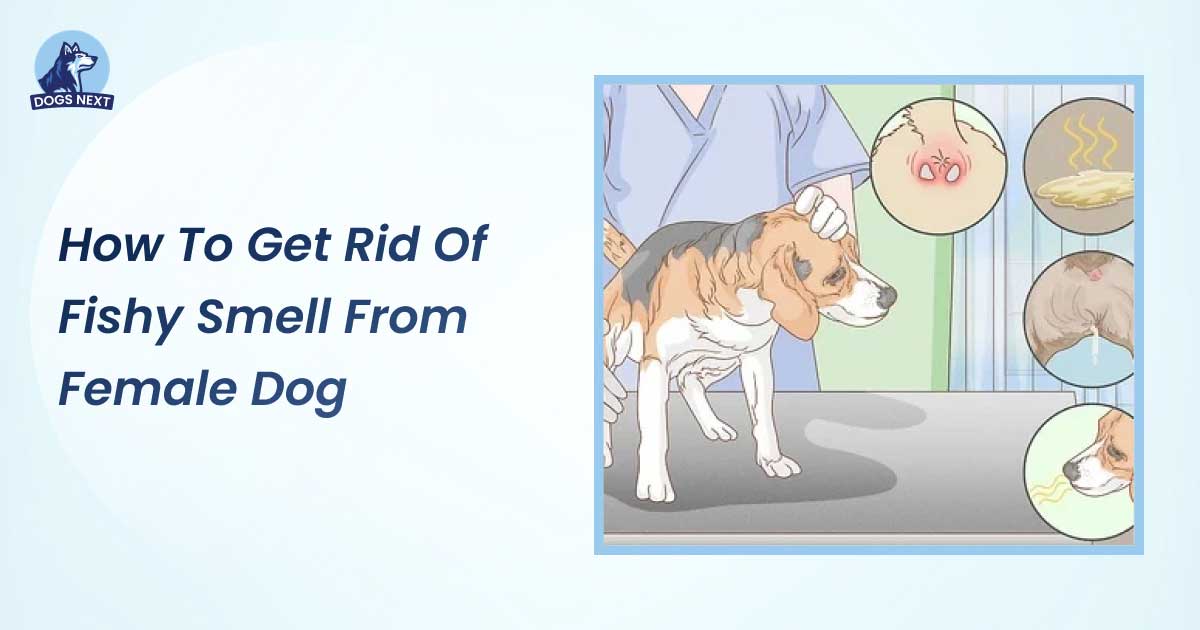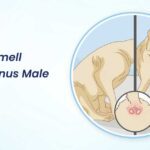To get rid of the fishy smell from your female dog, clean her with a dog-specific shampoo and consult a vet. The odor could indicate a health issue.
Dogs are beloved members of the family, and maintaining their hygiene is crucial for their well-being. A persistent fishy smell can be concerning and unpleasant. This odor often originates from the anal glands, which may require expression or indicate an underlying health problem.
Regular baths with dog-friendly shampoos can help, but it’s essential to consult your veterinarian. The vet can determine if the smell is due to an infection or other medical condition. Proper grooming, a balanced diet, and regular vet visits ensure your dog stays healthy and odor-free. Prioritizing your pet’s hygiene enhances her quality of life and keeps your home smelling fresh.
Common Causes Of Fishy Smell
Getting rid of a fishy smell from a female dog involves understanding the common causes behind it. This smell can be concerning, but knowing the reasons can help in addressing the issue effectively. Below are some common causes of fishy odor in female dogs.
Hormonal Changes And Heat Cycle
Hormonal changes in female dogs, especially during their heat cycle, can cause a fishy smell. During this period, the body produces more secretions, which may have a strong odor.
Key Points to Note:
- Heat cycle occurs twice a year in most female dogs.
- Increased vaginal secretions during this time can cause a noticeable smell.
- Proper hygiene is crucial to manage the odor.
Table: Heat Cycle and Odor Management TipsStageDurationManagement TipsProestrus7-10 daysUse pet-safe wipes, maintain cleanlinessEstrus5-9 daysFrequent baths, monitor vaginal areaDiestrus2 monthsRegular vet check-upsAnestrus4 monthsMaintain general hygiene
Keeping the vaginal area clean and using pet-safe products can help reduce the smell during the heat cycle.
Urinary Tract Infections (utis)
Urinary tract infections are another common cause of fishy smell in female dogs. UTIs can cause discomfort and a strong odor due to bacterial growth.
Symptoms of UTIs:
- Frequent urination
- Straining to urinate
- Blood in urine
- Strong-smelling urine
Table: UTI ManagementActionDescriptionVet VisitConsult a vet for diagnosis and treatmentAntibioticsPrescribed by the vet to eliminate infectionHydrationEnsure the dog drinks plenty of waterHygieneKeep the genital area clean
Regular vet check-ups and maintaining good hygiene can prevent UTIs and the associated fishy smell.
Skin Infections Or Allergies
Skin infections or allergies often cause a fishy smell in dogs. Bacterial or yeast infections on the skin can emit a strong odor.
Symptoms of Skin Issues:
- Itching and scratching
- Redness or inflammation
- Hair loss
- Scaly or flaky skin
Table: Skin Infection ManagementActionDescriptionVet ConsultationGet a proper diagnosisMedicated ShampoosUse vet-recommended shampoosTopical TreatmentsApply prescribed creams or ointmentsDietary ChangesConsider hypoallergenic diets
Maintaining regular grooming and using appropriate treatments can help manage skin infections and reduce the fishy smell.
Home Remedies To Eliminate Fishy Odor
Does your female dog have a fishy smell? This odor can be unpleasant and concerning. Luckily, there are several home remedies to eliminate the fishy odor effectively. These simple and natural solutions will help keep your furry friend smelling fresh and clean.
Regular Bathing With Dog-safe Shampoos
Bathing your dog regularly is crucial. Use dog-safe shampoos designed for sensitive skin. Avoid human shampoos as they can irritate your dog’s skin. Follow these steps for a proper bath:
- Brush your dog to remove loose fur and tangles.
- Wet your dog thoroughly with lukewarm water.
- Apply a dog-safe shampoo and lather well.
- Rinse completely to remove all shampoo residue.
- Dry your dog with a clean towel or blow-dryer on a low setting.
Frequency of bathing depends on your dog’s breed and activity level. Once a month is usually sufficient, but active dogs may need more frequent baths. Regular grooming can also help control odors.
Natural Deodorizers: Baking Soda And Vinegar
Baking soda and vinegar are excellent natural deodorizers. They are safe and effective in eliminating fishy smells. Here’s how to use them:
Baking Soda:
- Sprinkle a small amount of baking soda on your dog’s coat.
- Rub it in gently and let it sit for a few minutes.
- Brush it out thoroughly to remove excess powder.
Vinegar Solution:
- Mix equal parts of water and apple cider vinegar in a spray bottle.
- Lightly spray your dog’s coat, avoiding the eyes and ears.
- Allow it to air dry or pat dry with a towel.
Baking soda absorbs odors, while vinegar neutralizes them. Use these remedies once a week for best results. Always test a small area first to ensure your dog doesn’t have a reaction.
Maintaining A Healthy Diet For Your Dog
A healthy diet is essential for reducing odors. What your dog eats affects their smell. Here are some dietary tips:
- Provide high-quality dog food with natural ingredients.
- Avoid foods with artificial additives and preservatives.
- Include omega-3 fatty acids in their diet to improve skin health.
- Ensure proper hydration by providing fresh water daily.
Probiotics can also help. They promote a healthy gut, reducing bad odors. Consult your vet before adding supplements to your dog’s diet.
Regular vet check-ups are important. They can identify any underlying health issues causing the odor. A balanced diet, combined with proper grooming, ensures your dog stays fresh and healthy.
When To Consult A Veterinarian
It’s normal for dogs to have a slight odor. But a fishy smell from a female dog might be a sign of a health issue. Understanding when to consult a veterinarian can help ensure your dog’s well-being.
Signs That Indicate A Serious Issue
While some odor is typical, certain signs suggest a deeper problem. Pay attention to these symptoms:
- Persistent fishy smell: If the smell lingers despite regular cleaning.
- Excessive licking: Your dog may lick her genital area more than usual.
- Discharge: Noticeable discharge from the vagina, which can be white, yellow, or green.
- Swelling or redness: Inflammation around the genital area.
- Behavioral changes: Your dog seems more irritable or uncomfortable.
- Difficulty urinating: Straining or signs of pain when urinating.
If you observe any of these symptoms, seek veterinary advice. These signs could indicate infections, urinary issues, or other health concerns.
Diagnostic Tests And Treatments
Once at the vet, several diagnostic tests and treatments may be conducted:
- Physical Examination: The vet will check for visible signs of infection or abnormalities.
- Urine Analysis: Tests for urinary tract infections or other urinary issues.
- Vaginal Swab: Collects samples to identify bacterial or yeast infections.
- Blood Tests: Checks for systemic infections or underlying health problems.
Based on the findings, the vet may suggest treatments:
- Antibiotics: For bacterial infections.
- Antifungal Medications: For yeast infections.
- Special Shampoos or Wipes: To maintain genital hygiene.
- Dietary Changes: To improve overall health and reduce infections.
Early detection and treatment are vital. Regular vet visits ensure your dog stays healthy and happy.
Preventive Measures To Avoid Fishy Smells
Does your female dog have a fishy smell? This odor can be unpleasant and concerning. The good news is that there are ways to prevent this from happening. Preventive measures can keep your dog smelling fresh and healthy.
Regular Grooming And Cleaning
Regular grooming is crucial for preventing fishy smells. Frequent grooming helps maintain your dog’s hygiene and can identify any underlying issues. Here are some tips:
- Brush your dog’s coat daily to remove dirt and debris.
- Bathe your dog at least once a month with a dog-specific shampoo.
- Check the anal glands regularly, as these can cause a fishy smell if not expressed properly. This task may need a vet’s help.
- Trim the fur around the anal area to prevent buildup of dirt and bacteria.
Maintaining a regular cleaning schedule helps. Use the table below to keep track:
| Task | Frequency |
|---|---|
| Brushing | Daily |
| Bathing | Monthly |
| Anal Gland Check | Monthly |
| Fur Trimming | Bi-monthly |
Regular Grooming And Cleaning
Regular cleaning isn’t just about your dog’s coat. Dental hygiene is equally important. Poor oral hygiene can contribute to bad smells:
- Brush your dog’s teeth at least twice a week with a dog-specific toothbrush and toothpaste.
- Provide dental chews to help clean teeth and freshen breath.
- Regular vet check-ups can identify dental issues early.
Healthy ears also matter. Clean your dog’s ears weekly to avoid infections that cause bad odors:
- Use a vet-recommended ear cleaner.
- Gently wipe the outer ear with a cotton ball.
- Never insert anything into the ear canal.
Finally, pay attention to your dog’s diet. A balanced diet keeps your dog healthy and reduces bad smells:
- Choose high-quality dog food.
- Avoid foods with artificial additives.
- Provide fresh water daily.
Preventive measures like these ensure your dog stays fresh and happy. Regular grooming and cleaning are key to avoiding fishy smells.
Frequently Asked Questions
Why Does My Female Dog Smell Fishy?
A fishy smell can indicate anal gland issues in female dogs. These glands may be impacted or infected.
How Can I Get Rid Of The Fishy Odor?
Regular grooming and ensuring anal glands are expressed can help. Consult your vet for proper treatment.
Is A Fishy Smell In Female Dogs Normal?
No, a persistent fishy smell isn’t normal. It usually signals anal gland problems or infections.
Can Diet Affect My Dog’s Odor?
Yes, a dog’s diet can impact their smell. Consider a balanced diet and consult your vet for recommendations.
Conclusion
Eliminating a fishy smell from your female dog is manageable with the right steps. Regular grooming and proper hygiene are essential. Consult your vet for persistent issues. Keep your furry friend healthy and odor-free, ensuring a happy environment. Follow these tips for a fresh-smelling, happy pet.

I’m David, an expert contributor and writer, with two furry friends of my own, I know the challenges of raising and caring for dogs. From training to nutrition and health, my goal is to provide valuable insights and advice to help create strong bonds and happy, healthy lives. Find me in Twitter.




